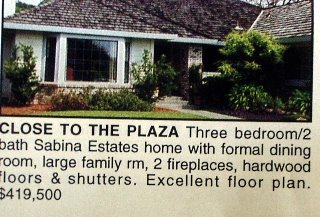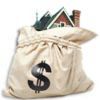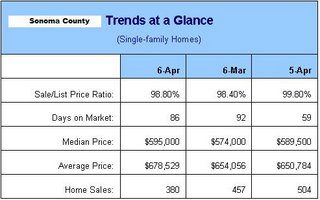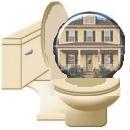 Headlines in History....Brought to you by Desidude who made this comment over at Ben's place
Headlines in History....Brought to you by Desidude who made this comment over at Ben's place.
Comment by desidude
2006-05-25 12:37:33 California History as it unfolded. thanks to a poster some time last year. we are still here.State’s Home Sales Drop 14% Median Price Tops$200,000 for First TimeCrouch, Gregory; Los Angeles Times; May 25, 1989;pg. IV1
It extended for more than a year.Realtors Hear Gloomy Price, Sales ForecastsMyers, David W; Los Angeles Times; Oct 7,
1990;pg. K1
1985-1986: Housing is booming, inventory is low.Housing Starts Surge 14.9% During January, BestGain in 20 MonthsLos Angeles Times (pre-1997 Fulltext);
Feb 20,1985; pg. 1
Inventory of Housing Dips in Southland Unsold New Homes Declined by 3.2% from End of 1984DAVID M. KINCHEN; Los Angeles Times (pre-1997Fulltext); Mar 16,
1986; pg. 1
Housing Sales Boom Keeps Inventories SlimDICK TURPIN; Los Angeles Times (pre-1997Fulltext); Aug 24,
1986; pg. 1
1987:
Housing still booming, prices increasing,inventories low. High-End Home Sales Push Up Median PriceDick Turpin; Los Angeles Times (pre-1997Fulltext); Mar 15, 1987; pg. 1
Inventory of Unsold Homes Sets New LowLos Angeles Times (pre-1997 Fulltext); Mar 15,1987; pg. 1
Fewer Homes, High Prices as Mortgage Rates ClimbTOM FURLONG; Los Angeles Times (pre-1997Fulltext); Sep 10, 1987; pg. 1
Fixed-Mortgage Interest Rates Surge Woes Mount forHome Buyers, BrokersTOM FURLONG; Los Angeles Times (pre-1997Fulltext); Sep 10, 1987; pg. 1
Unsold Homes Inventory Drops for Third TimeDAVID M. KINCHEN; Los Angeles Times (pre-1997Fulltext); Sep 13, 1987; pg.1
1988: People start to question the boom. Realtors assure us the boom will continue. Houses aren’t likestocks afterall.‘88 Outlook Bright for U. S. Real EstateDick Turpin; Los Angeles Times (pre-1997Fulltext); Jan 10, 1988; pg. 1
County’s Median Resale Price of Homes Reaches$179,999, Costliest in CaliforniaJOHN O’DELL; Los Angeles Times (pre-1997Fulltext); Mar 23, 1988; pg. 5
Unlike Stocks, Home Prices Rarely CollapseJAMES FLANIGAN; Los Angeles Times (pre-1997Fulltext); Aug 28, 1988; pg. 1
Southland Inventory of Unsold New Homes Lowest in DecadeDAVID M. KINCHEN; Los Angeles Times (pre-1997Fulltext); Sep 11, 1988; pg. 10
J. M. Peters Reports Skyrocketing Sales for Second QuarterMICHAEL FLAGG; Los Angeles Times (pre-1997Fulltext); Sep 14, 1988; pg. 5
Limit Issue Driving Up Home PricesDick Turpin; Los Angeles Times (pre-1997Fulltext); Sep 18, 1988; pg. 1
Hot Housing Sales Belie Doom ForecastRyon, Ruth; Los Angeles Times; Sep 25, 1988; Vol.107, Iss. 297; 8; pg. 1
1989: Prices are very expensive; affordability anissue. Sales slow and prices drop. Mention of riskyloan types.Housing Prices in State Climb 3% in FebruaryFurlong, Tom; Los Angeles Times; Mar 29, 1989;Vol. 108, Iss. 116; 4; pg. 1
Stock of Unsold Homes Drops DramaticallyDAVID M. KINCHEN; Los Angeles Times (pre-1997Fulltext); Apr 2, 1989; pg. 9
How First-Time Buyers Can Get Their Piece of the DreamMyers, David W; Los Angeles Times; May 21, 1989;pg. VIII1
State’s Home Sales Drop 14% Median Price Tops $200,000 for First TimeCrouch, Gregory; Los Angeles Times; May 25, 1989;pg. IV1
Sales of Existing Homes in State Fall During MayFurlong, Tom; Los Angeles Times; Jun 23, 1989;Vol. 108, Iss. 202; 4; pg. 1
Orange County Home Sales Drop by 22% in MayTOM FURLONG; Los Angeles Times (pre-1997Fulltext); Jun 23, 1989; pg. 1
Realtors Tackle New Topic: How to Handle SlowHousing MarketMyers, David W; Los Angeles Times; Oct 1, 1989;pg. VIII1
Prices Drop, Sales Slow in State’s Housing MarketTOM FURLONG; Los Angeles Times (pre-1997Fulltext); Nov 29, 1989; pg. 1
Housing Affordability Rises Outside L.A., Orange CountyKristof, Kathy M.; Los Angeles Times; Dec 06,1989; Vol. 109, Iss. 3; D; pg. 1
Survey Cites Four California Banks With Possibly Risky Realty LoansJAMES BATES; Los Angeles Times (pre-1997Fulltext); Dec 30, 1989; pg. 1
1990: Prices take a serious plunge. One article claimsthat housing booms are a bad thing and we should hopeprices stay low. Increasing mortgage rates are blamedfor the bust. The word “recession” is mentioned. Gloomand doom.Home Sales in Southland Plunge in ‘89Samuels, Alisa; Los Angeles Times; Feb 8, 1990;pg. D2
The Number of Homes for Sale Sets a Record RealEstate: San Diego becomes buyer’s market, with 4,000 existing homes listed in January.GREG JOHNSON; Los Angeles Times (pre-1997Fulltext); Feb 13, 1990; pg. 2.A
Pray That the Housing Boom Stays DeadJones, Robert A; Los Angeles Times; Apr 24, 1990;pg. A3
Climbing Mortgage Rates Hurt Existing Home SalesSamuels, Alisa; Los Angeles Times; Apr 26, 1990;Vol. 109, Iss. 144; D; pg. 3
California Is Nearing the Edge of Recession, UCLA Forecast WarnsAnderson, Harry; Los Angeles Times; Jun 29, 1990;Vol. 109, Iss. 208; D; pg. 1
California Real Estate Market Continues to CoolTOM FURLONG; Los Angeles Times (pre-1997Fulltext); Jul 26, 1990; pg. 1
Home Sales in July at Slowest Pace in 4 1/2 YearsFurlong, Tom; Los Angeles Times; Aug 28, 1990;Vol. 109, Iss. 268; D; pg. 2
Realtors Hear Gloomy Price, Sales ForecastsMyers, David W; Los Angeles Times; Oct 7, 1990;pg. K1
O.C. Home Resales, Prices Fall Sharply Housing:Realtors group attributes slump in county and statefigures to fears of recession.MICHAEL FLAGG; Los Angeles Times (pre-1997Fulltext); Oct 26, 1990; pg. 5
Housing Slump in California Seen WorseningTOM FURLONG; Los Angeles Times (pre-1997Fulltext); Nov 21, 1990; pg. 1
1991: A “dead cat bounce”? Some folks wondering if the bust has bottomed out or not. Sales are abysmal (e.g.,-42%). Other parts of the country showing some signs of recovery. Back to BasicsInman, Bradley; Los Angeles Times; Jan 20, 1991;pg. K1
Re-Assessing When Home Prices FallBoyer, Jeanne; Los Angeles Times; Feb 3, 1991; pg.K1
California Still Among Lagging Areas, Fed SaysJAMES RISEN; Los Angeles Times (pre-1997Fulltext); May 2, 1991; pg. 1
Reading Signs–Is Market at Bottom?Inman, Bradley; Los Angeles Times; Sep 8, 1991;pg. K1
County’s New-Home Sales Plunge 42% for Quarter *Real estate: New figures indicate the market issputtering again after a brief recovery. The inventory of unsold houses rose by 15%.GREGORY CROUCH; Los Angeles Times (pre-1997Fulltext); Oct 4, 1991; pg. 5
Home Sales Decline in CaliforniaLos Angeles Times; Nov 26, 1991; pg. D1
Home Sales Decline in California Housing: The drop in mortgage rates fails to spur sales in the state,but sales of existing homes across the country edge up in October.Los Angeles Times (pre-1997 Fulltext); Nov 26,1991; pg. 1
1992: No one is buying; housing is an investment that no one will touch. Desperate political efforts beingmade to encourage house buying. Rock bottom prices andlower mortgage rates encourage some purchasing. The year ends with some buying. Another “dead cat bounce”? It’s not clear.Move-Up Home Buyers Pretty Much Left Out Realestate: While Bush’s plan may boost first-timepurchases, it does little to dispel caution in theother key housing sector.JUBE SHIVER Jr.; Los Angeles Times (pre-1997Fulltext); Jan 30, 1992; pg. 4
Home Sales in State Fell 6.2% in 1991Shiver, Jube, Jr.; Los Angeles Times; Feb 12,1992; D; pg. 1
Spring Thaw Real estate: The local housing marketis showing signs of recovery. More realistic selling prices and reasonable interest rates have helped to spur sales.PATRICIA WARD BIEDERMAN; Los Angeles Times(pre-1997 Fulltext); Mar 26, 1992; pg. 1
Housing Starts Increase 6.4% to 2-Year High *Economy: A strong surge in apartment building leads the way, providing economists with more evidence of a sustained recovery.JUBE SHIVER Jr.; Los Angeles Times (pre-1997Fulltext); Apr 18, 1992; pg. 1
June Home Sales 3.5% over May but Trail 1991 FigureLos Angeles Times; Aug 2, 1992; pg. K1
August Housing Starts Rebound 10.4%,Marshall, Matt; Los Angeles Times; Sep 23, 1992;D; pg. 1
California Home Sales SurgeMyers, David W; Los Angeles Times; Nov 25, 1992;pg. D1
Sales of Existing Homes in California Rise AgainMyers, David W; Los Angeles Times; Dec 24, 1992;pg. D1
1993: It’s definitely a buyer’s market. Some people are saddened by the fact that current prices are 50% of what they were in the 1980’s.The housing bust in Southern California is clearly negatively impacting the California economy and the national economy at large. Sellers are desperate to sell (and some peopletaking extreme measures like putting huge “for sale”signs on their lawns for passing planes to see). Folks who waited out the boom to buy at the bottom are being handsomely rewarded for their patience. Proof-positive of the contrarian investing style — be greedy when everyone is fearful and fearful when everyone is greedy. The “slump” may be ending. Long Southland Housing Slump Finally Ending?DAVID W. MYERS; Los Angeles Times (pre-1997Fulltext); Feb 10, 1993; pg. 1
Housing Market Warming Up After 3-Year Slump Realestate: Optimism returns to Southland with rising sales. Number of homes on market is down.DAVID W. MYERS; Los Angeles Times (pre-1997Fulltext); Feb 10, 1993; pg. 1
A sad Westside story: Home prices have declined up to 50% since late 1980sMyers, David W; Los Angeles Times; May 28, 1993;D; pg. 1
Couple Put Up a Big Sign of the Real Estate Slump Housing: They write `For Sale’ in huge letters ontheir lawn, hoping to attract attention frompassengers in planes and jets on flight path to LAX.DICK WAGNER; Los Angeles Times (pre-1997; Apr 29,1993; pg. 8
Home Sales in County Climb by 3% Real estate: The market bucks the downward trend of neighboring areas. But analysts say don’t be too optimistic.STEPHANIE SIMON; Los Angeles Times (pre-1997Fulltext); May 28, 1993; pg. 1
It’s a Buyer’s Market as Peninsula Home Prices Tumble Real estate: Younger families are taking another look at an area that was once beyond their economic grasp. This could revitalize the school district.TED JOHNSON; Los Angeles Times (pre-1997; Jun 24,1993; pg. 3
Home Sales Up 6.3% in State, 4.6% Nationwide RealEstate: Analysts credit low interest rates and saybuyers are beginning to think that prices may have bottomed out.DAVID W. MYERS; Los Angeles Times (pre-1997Fulltext); Jun 26, 1993; pg. 1
California’s real estate slump deepensMiller, Greg; Los Angeles Times; Jul 27, 1993; pg.D2
Southland home values lead U.S.–DownwardMyers, David W; Los Angeles Times; Aug 4, 1993;pg. D1
Bottom Line: Housing Market May Be Mending RealEstate: Despite a three-year slump, experts say prices are stabilizing, especially for homes under $500,000.PATRICIA WARD BIEDERMAN; Los Angeles Times(pre-1997 Fulltext); Aug 22, 1993; pg. 1
Buyers Seek Bargains as Home Prices Keep Sliding Real estate: La Canada Flintridge emerges as brightspot with a nearly 21% increase in sales over sameperiod last year.ANDREW LePAGE; Los Angeles Times (pre-1997Fulltext); Sep 2, 1993; pg. 1
Sitting on the market: After the cash, owners adjust to the region’s housing slumpMyers, David W; Los Angeles Times; Sep 20, 1993;D; pg. 1
State’s bargain hunters boost new-home sales to 3-year highMyers, David W; Los Angeles Times; Oct 1, 1993;pg. D1
Home Sales Rise Sharply in State, Nation Realestate: Size of increase surprises housing analysts.Median price in California is down 4.3% from 1992 figure.DAVID W. MYERS; Los Angeles Times (pre-1997Fulltext); Oct 26, 1993; pg. 2
Jump in new-home sales spurs hopes of long-awaited revivalMyers, David W; Los Angeles Times; Nov 3, 1993;pg. D1
Drop in Southland Home Sales Slows in First 10 Months of ‘93Los Angeles Times (pre-1997 Fulltext); Nov 28,1993; pg. 4
U.S. home sales hit 14-year highMyers, David W; Los Angeles Times; Nov 30, 1993;pg. D1
Slump in O.C. Housing Market May Be Ending Realestate: November figures show a major year-to-year increase in the number of units sold. Median price still sags.JOHN O’DELL; Los Angeles Times (pre-1997Fulltext); Dec 21, 1993; pg. 1
1994: Housing begins its comeback. People who had the intelligence to wait for the bottom are buying now at great values. Even rising mortgage rates are not shaking the recovery.Bright Spots Some Areas Showing Signs of RecoveryAfter Four-Year Slump in Home PricesLos Angeles Times (pre-1997 Fulltext); Jan 16,1994; pg. 1
Lenders scramble to keep housing comeback aliveMyers, David W; Los Angeles Times; Mar 30, 1994;D; pg. 1
First-Time Buyers Who Waited Spark Housing Rebound Real estate: After years of ice-cold sales, the city’s Westside market is finally starting to heat up.SCOTT SHIBUYA BROWN; Los Angeles Times (pre-1997Fulltext); Jun 5, 1994; pg. 10
Home Sales Up 24% From Last YearLos Angeles Times (pre-1997 Fulltext); Jun 26,1994; pg. 6
June Home Sales Best in 5 Years Ventura County Is LeaderJack Searles; Los Angeles Times (pre-1997Fulltext); Jul 26, 1994; pg. 8
Rising mortgage rates shake but don’t break state housing industryLee, Patrick; Los Angeles Times; Oct 7, 1994; pg.D1
1995: Some parts of the Southland are recovering others are not. People with “negative equity” are in despair.Home Sales Rise 10.5% in State, Hit 5-Year HighJAMES F. PELTZ; Los Angeles Times (pre-1997Fulltext); Feb 9, 1995; pg. 1
Southland Home Price Rebound Fails to AppearJESUS SANCHEZ; Los Angeles Times (pre-1997Fulltext); May 22, 1995; pg. 1
County Home Sales Slide 20.4% in MayDAVID R. BAKER; Los Angeles Times (pre-1997Fulltext); Jun 13, 1995; pg. 1
Home sales surge 19% in May, raising doubts of rate cutMowbray, Rebecca; Los Angeles Times; Jun 30, 1995;D; pg. 1
Study of Homeowners Finds `Negative Equity’ a Problem Real estate: Nearly 5% owe more than homes areworth. Impact hinders the state’s economy, experts say.DEBORA VRANA; Los Angeles Times (pre-1997Fulltext); Jul 6, 1995; pg. 1
O.C. Real Estate Sales Drop Property: Preliminary figures for July suggest the county’s housing marketis still in a slump.DEBORA VRANA; Los Angeles Times (pre-1997Fulltext); Aug 1, 1995; pg. 1
1996: A tentative recovery is still in the making.
State’s housing market finally in turnaroundSanchez, Jesus; Los Angeles Times; Oct 25, 1996;pg. D1, 1
O.C. homeowners more confidentFulmer, Melinda; Los Angeles Times; Dec 3, 1996;pg. D.2
Ready to fly? Region’s housing prices on rise,moderatelySanchez, Jesus; Los Angeles Times; Dec 29, 1996;pg. D.1
1997: Finally, housing has recovered.
Southland Home Sales Are Unseasonably Hot Realestate: In O.C., October sales were 46.5% higher thanlast year. Median price of $208,000 was highest since1994.E. SCOTT RECKARD; Los Angeles Times; Nov 14, 1997;pg. 1
Median Price for O.C. Homes Surges 10.5%E. SCOTT RECKARD; Los Angeles Times; Dec 10, 1997;

 "Napa Valley Realtors and brokers have an informed perspective on what's happening in county real estate and the market's direction."
"Napa Valley Realtors and brokers have an informed perspective on what's happening in county real estate and the market's direction."
 What IS the goal then of today's buyer? They actually aspire to spend two to three times the cost to rent the same property just to have the privilege of renting from the bank?
What IS the goal then of today's buyer? They actually aspire to spend two to three times the cost to rent the same property just to have the privilege of renting from the bank?



























